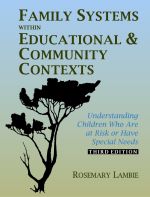 |
>FAMILY SYSTEMS WITHIN EDUCATIONAL AND COMMUNITY CONTEXTS
Understanding Children Who Are at Risk or Have Special Needs • Third Edition |
|
Rosemary Lambie
The third edition emphasizes at-risk children and those with special needs, and it includes a new chapter on violence and bullying in schools and communities. Every chapter has been extensively updated to reflect current literature and thinking. The content provides a wider systemic view of how professionals and family members can better serve children who are at risk for failure in school or in life.
This book explains major concepts and research findings on the family life cycle, family interactions, and other environmental factors that may affect children. It examines special populations, including families of divorce and remarriage as well as abusive or addictive families, and it provides specific strategies for working with these special children and their families. The applications section includes strategies, concrete exercises, and interventions.
Special Features
- Case Examples throughout the text
- Suggests interventions within the school system
- Discusses a wide range of families with special attention to diversity
- Develops pragmatic approach to understanding application of family systems concepts
- New chapter on bullying and violence in schools
Contents
Part 1: Description of Family Systems
Chapter 1: Introduction to the Family and Family Systems
Chapter 2: Family Life Cycle
Chapter 3: Family Interaction Patterns
Chapter 4: Historical Factors in Family Systems
Part 2: At-Risk Children, Resilient Children, and Children With Special Needs
Chapter 5: Socioeconomic and Cultural Factors in Families
Chapter 6: Families and Adoption
Chapter 7: At-Risk Children From Nontraditional Families
Chapter 8: At-Risk Children From Challenged Families
Chapter 9: Bullying and Violence in Schools and Communities
Chapter 10: Community Factors in Resilience
Part 3: Application of Family Systems
Chapter 11: Team Functioning and Family Involvement
Chapter 12: Family Conferences and Teacher–Student Support Teams
Chapter 13: Family-Focused Interventions and Individualized Education Programs
Chapter 14: Classroom and Group Extension of Family Systems Concepts
Chapter 15: Strengthening the Possibilities for a Systems Paradigm
- Appendix: Conceptual Frameworks of Family Systems Models
578 pages
Paperback
ISBN 978-0-89108-326-9
$88.00
|
|
|
|
|
 |
| >COMMUNICATING WITH PARENTS AND FAMILIES OF EXCEPTIONAL CHILDREN • Fourth Edition |
Roger L. Kroth and Denzil Edge
This book combines innovative strategies with daily activities designed to improve communication between the school and families of special needs children. The text addresses the changing family structure and takes the stance that parents and educators should be partners rather that combatants. Listening skills and positive communication are the heart of building positive relationships between family memebers and professionals. This text explains how to handle parent–teacher conferences, progress reports, group meetings, parent training, and planning programs.
This fourth edition takes an in-depth look at fostering the best relationship between teachers and parents. Classroom teachers, as well as special educators, will find this resource extremely useful in communicating with parents and addressing the needs of children with disabilities.
Special Features
- Addresses improved communication between parent and teacher
- Practical resource for teachers and organizations
- Handouts provided on several key topics
- Reflection questions follow each chapter
- Strategies for involving parents
Contents
- The Family in Today's Society
- The Mirror Model
- Family Dynamics
- Perceptions and Diversity of Values
- Listening Skills
- Parent–Teacher Conferences
- Informational Formats for Parents
- Reporting Progress
- Parent Group Meetings
- Defining the Problem
- Reinforcers and Reinforcement
- The Reinforecement Menu
- Parent Training Groups
- Assistive Technology and Assistive Devices
- What's Ahead
336 pages
2007/paperback/ISBN 978-0-89108-314-6
$56.00
|
 |
|
|
|
 |
| >TEACHING SOCIAL-EMOTIONAL SKILLS AT SCHOOL AND HOME |
|
Linda K. Elksnin and Nick Elksnin
Teaching Social–Emotional Skills at School and Home is designed to provide teachers and parents with strategies for teaching children and youth to become socially and emotionally competent.
This book is research-based yet practical and easy to read. The authors examine all aspects of social–emotional learning, including emotional literacy, social problem solving, and the social skills essential for making friends and succeeding in school—making this text the most comprehensive available.
Readers will learn how to teach social–emotional skills at the individual, classroom, schoolwide, and districtwide levels by integrating instruction within the academic curriculum and how to make social–emotional learning part of school and family life.
Special Features
- Includes assessment approaches to identify children who need social–emotional skills instruction
- Contains practical activities to help children of all ages understand and regulate emotions, make and keep friends, solve social problems, and succeed in school
- Addresses the importance of social–emotional skills for gaining and maintaining employment
- Incorporates real-life vignettes that connect theory and practice
- Provides numerous useful forms, checklists, and planning sheets
Contents
- The Importance of Social–Emotional Competence
- Identifying Children and Youth Who Need Social–Emotional Skills Instruction
- Teaching Children and Youth to Understand and Regulate Emotions
- Teaching Children and Youth Social–Emotional Problem-Solving Strategies
- Teaching Children and Youth Peer-Pleasing Social–Emotional Skills
- Teaching Children and Youth Teacher-Pleasing Social–Emotional Skills
- Teaching Occupational Social–Emotional Skills
- Parents as Teachers
- Getting Children and Youth to Use Social–Emotional Skills
- Appendix A: Books for Parents, Children & Youth, and Teachers & Administrators
- Appendix B: Children’s Books Chosen by Children
0603/352 pages/2006
Paperback
ISBN 978-0-89108-316-0
$60.00
|
|
|
|
|
|



